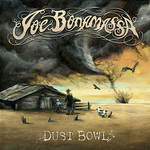Dust Bowl
Studio Album by Joe Bonamassa released in 2011Dust Bowl review
Bonamassa’s ordinary miracles
Joe Bonamassa has released another studio album. Should it be much of a surprise? No, because we all take it for granted. This marvelous musician has never afforded a long break between his visits to studio and has bee delivering CDs regularly in more than ten years now. As soon as you get used to his last album, he’s got a fresh one for you, and there is never any doubt about its quality. Stability and diligence make Bonamassa a man of great labor. But what makes him a truly outstanding performer is his virtuous guitar play. And when you add here a huge supply of ideas and a very nice vocal you have an unsurpassed musician whom you can always set as an example to all of those who are only beginning. The maestro’s newly made album is called Dust Bowl, decorated with a beautiful artwork and, according to Joe’s words, is the best work to date in his discography. We have all reasons to believe him considering the fact that he was in his artistic prime when he launched the making of this record. How did he manage to pen another twelve songs and record them so soon once again is a question we can hardly solve. Instead, we are blessed with an opportunity to enjoy this music in full.
Blues and other sweets on Dust Bowl
By the moment of creating Dust Bowl Joe Bonamassa had already carried himself out of stylistic borders and clichйs, which are so necessary for critics to evaluate music works. Bonamassa’s music ceased to be blues in the classic meaning of the word for it contains too many elements of other schools and traditions making it almost impossible to say what is basic here and what is secondary. And there is no need to do it. With the first sounds of Slow Train you stop caring what kind of music this is and just want to listen. Erected on a solid bass foundation, this song is like a train taking you far into the distances of the unfolding album. Joe is going to take us on a little journey across various music landscapes. The title song is a typical piece of soundtrack to a good western, while the following track, Tennessee Plates, is a pure country with only piano and guitar, but there is nothing else you need here. To keep you alert and awake, the record provides a good portion of ringing and noisy rock and roll, like The Whale That Swallowed Jonah. However, no matter where the track-list takes you, it always brings you back to blues. The best blues here is found in the beautiful ballad The Last Matador Of Bayonne, and the final track Prisoner, an effective end to the whole voyage.
Thank you, Joe, for being around
Dust Bowl is an independence holiday. Freely does Joe Bonamassa cross genre boundaries! Freely does he produce notes out of his instrument arranging them into fancy melodies! Freely does the album breathe because no flaws, mistakes or inaccuracies hinder that breathing! You can listen to the new work by the American hero of six strings an uncountable number of times and each new time you will make little music discoveries here. Every solo here is a separate story with genuine emotions and flaming passions. Each streak of riffs is a powerful blow of energy sending thrills from head to feet. Dust Bowl is an amazing example of well-organized team work involving, apart from Joe, guest vocalists, his group of musicians and the established producer Kevin Shirley. Still, there is only one figure here who is absolutely irreplaceable, and this is Joe Bonamassa. Without him there would not be this brilliant album. What a great thing this is to have him around, young and eager to make so many more excellent albums like this one!

